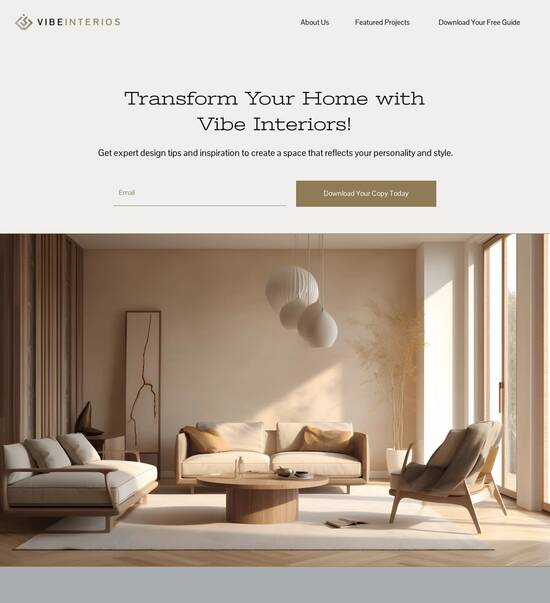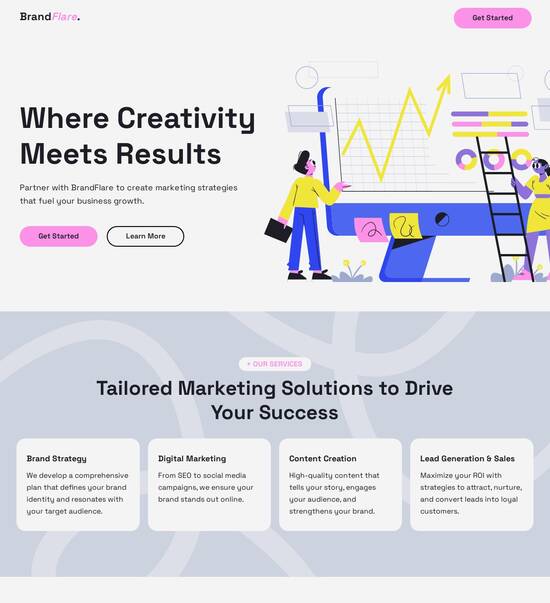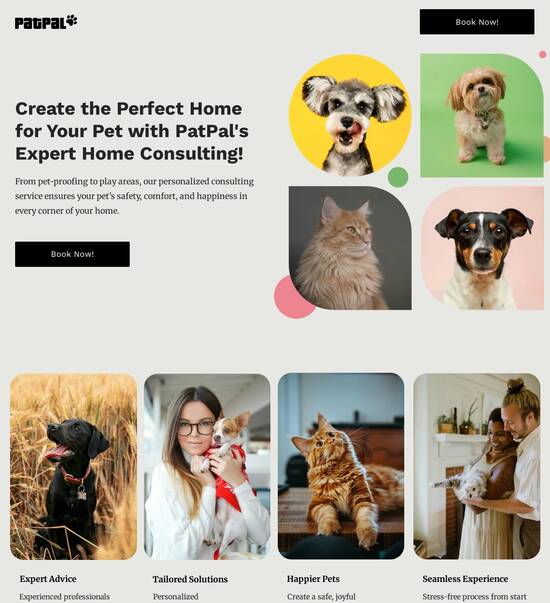
React.js optimized conference page template
Explore Similar TemplatesAbout template
Supercharge your conference page with React.js for outstanding performance! Learn more today.
Recommended templates

Easy to build without coding
With the intuitive drag-and-drop builder, anyone on your team can create high-converting pages without any knowledge of code or design. Make enhancements to your landing page with custom widgets using Javascript, HTML/CSS, or third-party scripts.

Multiple layouts for any industry and goal
Select from 500+ landing page layouts built to boost conversions across industry-specific scenarios. Customize them by adjusting fonts, adding images, and generating on-brand content with the AI assistant. Quickly scale with Instablocks® and Global Blocks that you can save, reuse, and update globally.

Loads fast and looks polished on any device
Every template is responsive, which means they present professionally on any device and load blazingly fast with our Thor Render Engine. You can also power them up with Google AMP technology to deliver an unparalleled mobile experience and drive higher conversions.

Robust analytics & experimentation
Get real-time updates and reporting across all your devices, showing the number of visitors, conversions, cost-per-visitor, and cost-per-lead. Launch AI-powered experiments, run A/B tests, and use heatmaps to analyze user behavior, then optimize your landing page to maximize conversions.







Easy to build without coding
With the intuitive drag-and-drop builder, anyone on your team can create high-converting pages without any knowledge of code or design. Make enhancements to your landing page with custom widgets using Javascript, HTML/CSS, or third-party scripts.
Multiple layouts for any industry and goal
Select from 500+ landing page layouts built to boost conversions across industry-specific scenarios. Customize them by adjusting fonts, adding images, and generating on-brand content with the AI assistant. Quickly scale with Instablocks® and Global Blocks that you can save, reuse, and update globally.
Loads fast and looks polished on any device
Every template is responsive, which means they present professionally on any device and load blazingly fast with our Thor Render Engine.
Robust analytics & experimentation
Get real-time updates and reporting across all your devices, showing the number of visitors, conversions, cost-per-visitor, and cost-per-lead. Launch AI-powered experiments, run A/B tests, and use heatmaps to analyze user behavior, then optimize your landing page to maximize conversions.
All the features you need to build lead-generating landing pages
Explore more featuresLearn how to build top-performing landing pages for any goal
FAQs
Leading the way in building high-performing landing pages





Maximize Your Marketing with Instapage's Powerful Landing Page and CRO Platform
Landing pages are critical for any digital marketing strategy, particularly in sectors such as business services, tech/SaaS, and education. Instapage provides the most comprehensive solution for creating high-converting landing pages, ensuring that marketers can accelerate and optimize their campaigns effectively. With over 100 customizable templates designed for conversion optimization, you can launch a stunning landing page without needing technical expertise.
Understanding the Importance of Optimized Landing Pages
Optimized landing pages mean higher conversion rates. In sectors like financial services and insurance, every lead counts. A well-designed landing page is often the first point of contact in the customer journey. With Instapage, personalization features help tailor the content to specific audience segments, addressing the unique needs of different verticals within the USA.
- Enhanced lead generation: Leveraging high-converting templates can significantly boost lead capture.
- Increased conversion rates: Data-driven A/B testing ensures your page is continuously improving.
- Tailored user experiences: Using dynamic text replacement further personalizes your landing pages.
Steps to Create Your Landing Page with Instapage
Creating a landing page with Instapage involves a straightforward process that anyone on your marketing team can handle. Follow these steps to get started:
- Select a template: Choose from over 100 pre-built templates that suit your campaign goals.
- Customize your content: Utilize our intuitive drag-and-drop builder to adjust text, images, and layouts.
- Implement lead generation elements: Add forms or buttons that align with your call to action.
Optimizing Your Landing Page for Success
Post creation, the next crucial step is optimizing for performance.
- Conduct A/B testing: Test different headlines and images to identify what resonates most with your audience.
- Utilize heatmaps: Understand user interaction on your page to inform future design decisions.
- Analyze performance: Leverage our analytics dashboard to track KPIs and refine your strategy.
In conclusion, leveraging the full capabilities of Instapage positions your marketing campaigns for success and ensures a robust ROI, especially in well-regulated industries like government and utilities.
Start optimizing your landing pages today with Instapage. Discover how our powerful tools can transform your digital marketing efforts, making every dollar spent work harder.
ReactJS optimized conference page template
The vision of a conference page: unlocking possibilities with ReactJS
In the world of virtual gatherings and events, having a well-optimized conference page stands as a crucial element in improving attendee experience and driving event success. A thoughtfully designed conference page not only serves as a hub for important information but also sets the tone for attendee engagement and interaction. The significance of an optimized conference page lies in its ability to streamline information dissemination, facilitate easy registrations, and provide attendees with everything they need at their fingertips.
User experience (UX) plays a fundamental role in encouraging attendance. A page that is cluttered or cumbersome can frustrate potential attendees, leading them to abandon the idea of participating. By blending aesthetics with functionality, you can create a visually appealing platform that stands out while providing seamless navigation. This balance is essential to guiding users effortlessly through the registration process, accessing information about speakers, and exploring the agenda.
Create an inviting landing page that captures attention.
Incorporate user-centric design principles for better navigation.
Ensure all important information is easily accessible.
The power of reactjs in web development
ReactJS has established itself as a powerful library favored by developers for building user interfaces with unmatched efficiency. With its component-based architecture, React allows for modular development, making it easier to manage and reuse code across different pages. This not only enhances productivity but also promotes a cleaner, more organized codebase. Each component can be designed for specific functions, and when combined, they can produce a robust user interface tailored to various needs.
Another significant feature of React is its virtual DOM, which drastically improves rendering time. By minimizing direct manipulation of the actual DOM, React efficiently updates the UI through a process known as reconciliation. This performance optimization translates to a smooth browsing experience, especially critical for interactive elements on a conference page that require quick updates, such as registration confirmation or live polling.
Develop reusable components that enhance code efficiency.
Leverage React's virtual DOM for improved performance.
Stay updated with new React features for continual improvement.
Key components of an optimized conference page template
When structuring your conference page, it's vital to include components that serve specific purposes and enhance user engagement. Essential components of a successful conference page should include a header with the event title and branding, a detailed agenda section outlining sessions, captivating speaker profiles, user-friendly registration forms, an FAQ section addressing common concerns, and a sponsor showcase to provide visibility to partners.
Utilizing reusable components to streamline development can significantly cut down on the time needed for page creation. In addition, adapting content presentation to align with the specific needs of your audience fosters deeper engagement. Whether your event is focused on tech advancements, educational growth, or business services, the ability to tailor content dynamically can make a noteworthy impact.
Header and event title to establish brand identity.
Agenda section to outline the event schedule.
Speaker profiles that highlight expertise and credentials.
User-friendly registration forms for ease of sign-up.
FAQ section to alleviate common attendee inquiries.
Sponsor showcase to enhance visibility and collaboration.
Page design elements that enhance engagement
Design plays a pivotal role in retaining user interest, and visual hierarchy is essential for showcasing the most important elements. By adjusting the size and placement of key components, such as the event announcement or registration button, you create a natural flow that guides users through the page. This ensures that they notice and interact with critical information easily.
Choosing the right images is equally crucial, as they work in tandem with your content to provide context and make the information more relatable. Images should evoke feelings aligned with your event theme and objectives. Furthermore, color schemes and typography are vital in establishing brand recognition while ensuring readability. Opting for clear fonts and contrasting colors means that critical content doesn't get lost in the visual landscape.
Establish visual hierarchy by prioritizing key elements.
Choose contextually relevant imagery that enhances understanding.
Use color schemes and typography that align with branding and readability.
Leveraging react libraries for enhanced functionality
React’s ecosystem boasts an array of libraries that can help enhance the functionality of your conference page. State management is paramount, especially for a dynamic environment, and utilizing libraries like Redux or the Context API can facilitate this efficiently. Implementing routing with React Router ensures smooth navigation across the app without page reloads, which is crucial for a seamless user experience during the event.
Form management tools like Formik or React Hook Form can simplify the process of handling user inputs, making registration forms intuitive and responsive. Additionally, animation libraries such as Framer Motion can breathe life into transitions, providing a polished and engaging feel to the user interface. Alerts and modals become essential for notifying users of real-time updates or confirmations, and implementing libraries like react-modal can enhance interactivity throughout the experience.
Manage state effectively with Redux or Context API.
Use React Router for intuitive navigation across pages.
Simplify form handling with Formik or React Hook Form.
Incorporate animations using Framer Motion for smooth transitions.
Utilize react-modal for alerts and real-time notifications.
Optimizing image usage and performance
Images are an integral part of any conference page, but using them responsibly is vital for maintaining performance. Optimized images help in reducing load times while still delivering quality visuals. Before incorporating images, it's essential to find the right balance between size and quality, ensuring that visuals don’t detract from the user experience but instead enhance it.
Adopting image loading strategies such as lazy loading can significantly help in optimizing performance as it only loads images when they are in the user's viewport. This technique improves loading speeds and enhances overall responsiveness. Additionally, leveraging tools like react-image allows developers to specify placeholders while images load, further enhancing user engagement and satisfaction.
Utilize optimized image formats for quick loading.
Implement lazy loading to defer off-screen images.
Leverage libraries like react-image for better image management.
The approach to developing an optimized conference page
A successful development process starts with careful planning, beginning with defining user personas. By understanding the different types of attendees who will engage with the page, you can tailor the design to meet their specific needs. Creating wireframes and prototypes can help visualize the layout before diving into code, allowing stakeholders to assess the flow and structure of the page.
Establishing a project structure early on is also crucial. Developers can choose between a component-driven approach or more traditional methods, but employing React’s component architecture typically yields more manageable and adaptable code. This organization enables developers to build core components effectively, establish props for data flow, and integrate APIs that provide real-time data, such as updates on speakers’ details or registration status.
Define user personas to inform design decisions.
Create wireframes and prototypes for initial visualization.
Set up project structure based on component approach.
Integrate APIs for dynamic data updates.
The advantages of an optimized conference page template
An optimized conference page template can significantly improve user experience and engagement metrics. Fast load times directly correlate with lower bounce rates, ensuring that more potential attendees remain on your page. Interactive elements powered by React’s rendering engine allow for enhanced user engagement, encouraging visitors to explore deeper and interact with features such as the agenda or speaker bios.
Additionally, streamlining the event management process becomes simpler with an optimized template. Real-time updates enable users to stay informed with minimal effort, while a simplified registration process facilitates higher attendance rates. Furthermore, dedicated sections for sponsors promote visibility and create additional revenue opportunities, making the template beneficial for all stakeholders involved.
Faster load times lead to lower bounce rates.
Enhanced interactivity through optimized rendering.
Community building enabled through integrated social features.
Dynamic features driving conference page innovations
To meet modern user expectations, integrating interactive elements on the conference page is crucial. Features like live polls can foster engagement by soliciting immediate feedback from attendees, thus enhancing their connection to the content presented. Additionally, video integrations support hybrid events by catering to both livestream and in-person audiences, enabling a broader reach and enhancing the experience for remote users.
Incorporating chatbots and support systems can significantly enhance user satisfaction by providing real-time assistance and answering queries quickly. These innovations not only streamline processes but also demonstrate an understanding of attendees' needs. Best practices surrounding content layout and usability should include considerations for accessibility; for instance, implementing features that accommodate various user requirements ensures a more inclusive event experience.
Integrate live polls and Q&A functionalities.
Use video integrations to enhance hybrid event experiences.
Implement chatbots for real-time assistance during the event.
Real-world case studies: success stories of ReactJS conference pages
Examining notable examples of well-implemented ReactJS conference pages can provide tremendous insight into effective strategies. Analyzing successful case studies reveals best practices such as streamlined registration processes, responsive design elements, and engaging content layouts. These success stories often highlight how essential components were efficiently integrated to create an outstanding user experience, instilling confidence and excitement among attendees.
On the other hand, it’s equally important to learn from failed attempts. Identifying common pitfalls, such as convoluted navigation or information overload, can help prevent similar issues in future page designs. Engaging with users post-event for feedback can reveal areas for ongoing improvement, and iterating upon the template based on user experience metrics ensures that future events harness the best practices learned from previous experiences.
Highlight successful implementations in notable conferences.
Learn from failures and avoid common pitfalls.
Engage with users for continuous improvement and feedback.
Future trends in conference page design
As technology continues to evolve, the landscape of event design will likewise transform. Emerging trends in event technology suggest the potential integration of augmented reality (AR) and virtual reality (VR) to create immersive experiences for attendees. Implementing these technologies could lead to captivating virtual environments that enrich interactions between speakers and participants.
Furthermore, AI-driven personalization is anticipated to play a crucial role in enhancing attendee engagement. By analyzing user behavior and preferences, AI can tailor content and recommendations, providing attendees with curated experiences that resonate with their interests. Additionally, sustainability is becoming a significant focus in conference planning, and future templates should reflect a commitment to eco-friendly practices while maintaining effective engagement.
Explore augmented reality and virtual reality integrations.
Leverage AI-driven personalization for enhanced user experience.
Focus on sustainability in conference planning.
Ready to skyrocket conversions?
Supercharge your ad campaigns with high-performing landing pages
Get started














